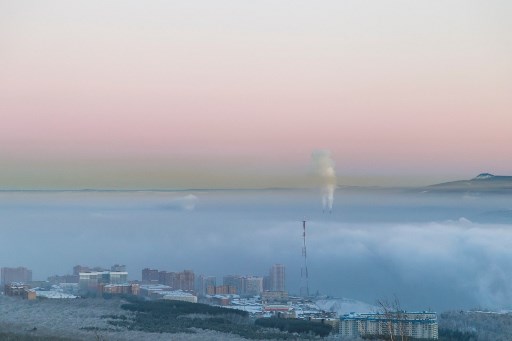
by Victoria Loguinova-Yakovleva
Agence France Presse
MOSCOW, Russia (AFP) — Weary of local officials dismissing the deadly smog that covers their city, citizens of Siberia’s industrial hub Krasnoyarsk decided to take action and monitor air quality themselves.
But they quickly came up against those same authorities in the remote region 4,200 kilometers (2,600 miles) east of Moscow.
Krasnoyarsk boasts dozens of factories as well as one of the world’s biggest aluminium plants. The natural resources and environment minister recently ranked it as one of Russia’s most polluted cities.
Yet little had been done to investigate air quality.
A dedicated group, led by 34-year-old Igor Shpekht, last May resolved to change that.
“A fog regularly appears over Krasnoyarsk and people have difficulty breathing,” he told AFP.
‘We are being duped’
“But weather services say the concentration of harmful elements does not exceed the norm. Because of this incoherence, we have the impression that we are being duped.”
In Russia, the official fine particle pollution danger level is 40 percent higher than that set by the World Health Organization. Local weather services use a so-called “standard index,” but according to their data, pollution is always relatively low.
“After several years of inaction from the ministry of ecology and local weather services, we decided to measure pollution levels ourselves,” Shpekht said.
The group installed seven French-made devices at the end of 2017 to measure tiny particles suspended in the air.
Their data is now published in real time on the website Krasnoyarsk Sky (krasnoyarsknebo.ru) as well as social media and mobile phone apps.
The results regularly show pollution levels exceeding the norm, sometimes greatly so.
On a visit to Krasnoyarsk on February 7, President Vladimir Putin ordered officials to come up with a plan to improve the dire ecological situation “without any delay.”
Sensitive issues
“I’ve heard that this is one of the most sensitive issues,” said Putin, who is running for a historic fourth term in Russia’s March elections.
“Let the president breathe our air,” Krasnoyarsk Sky activists responded on Instagram.
Due to a lack of funding, many Russian air quality control systems have not been modernised since the fall of the Soviet Union. In some cities, they do not exist at all.
“You want to test the quality of the air? We are ready to do it. On condition that we receive financing,” Maksim Yakovenko, the chief of Russia’s Federal Service for Meteorology, recently told Kommersant newspaper.
The devices installed by Shpekht measure levels of the fine PM2.5 particles that are particularly toxic, penetrating deep into the respiratory tract.
The WHO says average daily PM2.5 concentrations should not exceed 25 micrograms per cubic meter while Russian authorities set the danger level at 35 micrograms.
In early February, the Krasnoyarsk activists, who follow the American Air Quality Index and WHO, recorded hazardous concentrations of 200 micrograms per cubic meter.
Exposure can lead to cancer, asthma, and allergies as well as respiratory and cardiovascular diseases.
The Siberian project initially angered the authorities who are often suspicious of independent grassroot initiatives.
Local weather services filed a complaint against Shpekht for not having a license.
“People can measure the levels of pollution but, according to law, they cannot publish the data on the internet,” Krasnoyarsk’s weather department spokesperson Oksana Salnikova told AFP.
Outdated equipment
But she admitted that due to a lack of funding her department did not have the necessary equipment to monitor PM2.5 levels.
“Our equipment has not been modernised in years. We currently measure bodies of PM particles without distinguishing them in size,” Salnikova explained.
In the end, the Russian environment ministry and its Krasnoyarsk branch backed Shpekht and the court rejected the complaint in December.
“We are in contact with the ecologists. Under pressure from them our ministry finally bought the equipment to measure PM2.5 particles,” a spokesperson for the ministry in Krasnoyarsk told AFP.
“We have a mobile laboratory. When people tell us that the levels of these harmful elements is high, we go out to check the data,” she added.
The Siberian initiative has inspired other Russian cities to follow suit.
Igor Shpekht said he was contacted by people living in other major industrial hubs such as Magnitogorsk and Chelyabinsk in the Urals and the Far East’s Komsomolsk-on-Amur.
“We are ready to help them,” he said.
Shpekht added, however, that he still faces the threat of a trial and is ready for it.
“We would like this trial to take place so that we can once and for all prove that we are right,” he said.
© Agence France-Presse







